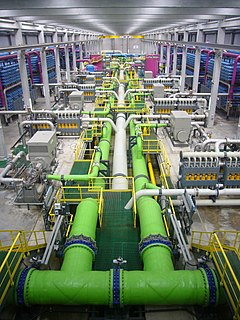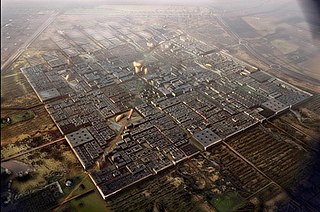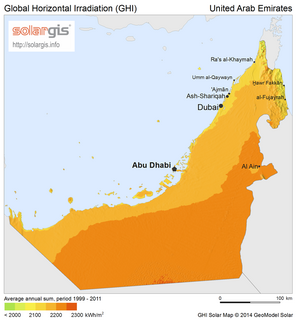Dubai is a city in the United Arab Emirates and is recognized as one of the fastest-growing cities in the world. This rapid urbanization has led to many environmental issues, because of the harsh environment, paucity of local resources such as food, water, and building materials, and the unplanned manner of expansion.
One major environmental issue in Dubai is potential water shortage. Dubai is among the cities with the lowest levels of precipitation.[ citation needed ] At the same time, the emirate is ranked among the top three countries in water usage, alongside the United States and Canada. Due to this fundamental conflict, water in Dubai comes mainly from energy-intensive desalination of sea water. [1] [2]
As climate change and human-induced greenhouse gas emissions have increasingly caused distorted weather patterns and unpredictable precipitation, farmers cannot access reliable water sources for irrigation. As a result, food prices are affected. [3] Economic boom and population growth resulting from the discovery of oil in the UAE (1958) triggered increased demand for water that has ultimately led to water shortages. In the past, the UAE relied on desalination to respond to this increase of demand. [4] There have been attempts to decrease demand for water in the UAE, such as increased fees for water usage. [4]
In order to limit demand for and usage of electricity and water, prices have increased significantly for residents in Dubai. [5] There are many developments being made in Dubai to maximize the utility of water available, such as The Sustainable City, a housing development where water and waste are recycled and residents pay rent that is similar to other nearby developments. [5] It is also required that new buildings have solar water heaters. [5] Per capita consumption of water and electricity has been falling as the population of Dubai continues to increase, which is promising for sustainability efforts being made. Recent efforts to address low levels of precipitation include meteorologists at Dubai's National Center of Meteorology & Seismology monitoring clouds and sending pilots to seed them with salt crystals to maximize their output of rain. [5]
Dubai is a major consumer of electricity[ citation needed ]. Their main source of electricity is natural gas, because it is cheaper than the alternatives. Many of the isolated buildings depend on large quantities of fossil fuel energy to support their large lighting and cooling needs. [6]
Among the biggest problems facing Dubai is its rapid, unplanned manner of expansion. [7] Other challenges have arisen as a result of rapid expansion, such as sewage treatment systems that have failed to keep up with development. [8]
In the future, global warming will become a bigger issue, and this could be a huge problem for Dubai, because the country's population centres are located along the coast. Rising seas could lead to flooding, creating a problem for the city, as it would have few resources to counter the issue.

The United Arab Emirates is situated in the Middle East and southwest Asia, bordering the Gulf of Oman and the Persian Gulf, between Oman and Saudi Arabia; it is at a strategic location along the northern approaches to the Strait of Hormuz, a vital transit point for world crude oil. The UAE lies between 22°50′ and 26° north latitude and between 51° and 56°25′ east longitude. It shares a 19 km (12 mi) border with Qatar on the northwest, a 530 km (330 mi) border with Saudi Arabia on the west, south, and southeast, and a 450 km (280 mi) border with Oman on the southeast and northeast.

The economy of the United Arab Emirates is the 5th largest in the Middle East, with a gross domestic product (GDP) of US$501 billion in 2022.

Desalination is a process that takes away mineral components from saline water. More generally, desalination refers to the removal of salts and minerals from a target substance, as in soil desalination, which is an issue for agriculture. Saltwater is desalinated to produce water suitable for human consumption or irrigation. The by-product of the desalination process is brine. Desalination is used on many seagoing ships and submarines. Most of the modern interest in desalination is focused on cost-effective provision of fresh water for human use. Along with recycled wastewater, it is one of the few rainfall-independent water resources.

Water conservation includes all the policies, strategies and activities to sustainably manage the natural resource of fresh water, to protect the hydrosphere, and to meet the current and future human demand. Population, household size and growth and affluence all affect how much water is used. Factors such as climate change have increased pressures on natural water resources especially in manufacturing and agricultural irrigation. Many countries have already implemented policies aimed at water conservation, with much success. The key activities to conserve water are as follows: any beneficial reduction in water loss, use and waste of resources, avoiding any damage to water quality; and improving water management practices that reduce the use or enhance the beneficial use of water. Technology solutions exist for households, commercial and agricultural applications. Water conservation programs involved in social solutions are typically initiated at the local level, by either municipal water utilities or regional governments. Common strategies include public outreach campaigns, tiered water rates, or restrictions on outdoor water use such as lawn watering and car washing.

District cooling is the cooling equivalent of district heating. Working on broadly similar principles to district heating, district cooling delivers chilled water to buildings like offices and factories needing cooling. In winter, the source for the cooling can often be seawater, so it is a cheaper resource than using electricity to run compressors for cooling. Alternatively, District Cooling can be provided by a Heat Sharing Network which enables each building on the circuit to use a heat pump to reject heat to an ambient ground temperature circuit.

Masdar City is a planned city project in Abu Dhabi, in the United Arab Emirates. Its core is being built by Masdar, a subsidiary of Mubadala Development Company, with the majority of seed capital provided by the Government of Abu Dhabi. Designed by the British architectural firm Foster and Partners. The city relies on solar energy and other renewable energy sources.
Water supply and sanitation in Saudi Arabia is characterized by challenges and achievements. One of the main challenges is water scarcity. In order to overcome water scarcity, substantial investments have been undertaken in seawater desalination, water distribution, sewerage and wastewater treatment. Today about 50% of drinking water comes from desalination, 40% from the mining of non-renewable groundwater and only 10% from surface water in the mountainous southwest of the country. The capital Riyadh, located in the heart of the country, is supplied with desalinated water pumped from the Persian Gulf over a distance of 467 km. Water is provided almost for free to residential users. Despite improvements, service quality remains poor, for example in terms of continuity of supply. Another challenge is weak institutional capacity and governance, reflecting general characteristics of the public sector in Saudi Arabia. Among the achievements is a significant increase in desalination, and in access to water, the expansion of wastewater treatment, as well as the use of treated effluent for the irrigation of urban green spaces, and for agriculture.

Peak water is a concept that underlines the growing constraints on the availability, quality, and use of freshwater resources.

Water resources are natural resources of water that are potentially useful for humans, for example as a source of drinking water supply or irrigation water. 97% of the water on the Earth is salt water and only three percent is fresh water; slightly over two thirds of this is frozen in glaciers and polar ice caps. The remaining unfrozen freshwater is found mainly as groundwater, with only a small fraction present above ground or in the air. Natural sources of fresh water include surface water, under river flow, groundwater and frozen water. Artificial sources of fresh water can include treated wastewater and desalinated seawater. Human uses of water resources include agricultural, industrial, household, recreational and environmental activities.

Abu Dhabi is the capital and the second-most populous city of the United Arab Emirates. It is also the capital of the Emirate of Abu Dhabi and the centre of the Abu Dhabi Metropolitan Area.
The Abu Dhabi National Energy Company, PJSC (TAQA) is a government controlled energy holding company of Abu Dhabi, United Arab Emirates.

The water-energy nexus is the relationship between the water used for energy production, including both electricity and sources of fuel such as oil and natural gas, and the energy consumed to extract, purify, deliver, heat/cool, treat and dispose of water sometimes referred to as the energy intensity (EI). The relationship is not truly a closed loop as the water used for energy production need not be the same water that is processed using that energy, but all forms of energy production require some input of water making the relationship inextricable.
The three cities of Abu Dhabi Emirate within the United Arab Emirates – the coastal city Abu Dhabi itself as well as the inland oases Al Ain and Liwa – receive their drinking water supply entirely from desalinated seawater.
Energy in the United Arab Emirates describes energy and electricity production, consumption and import in the United Arab Emirates (UAE). UAE has 7% of global proved oil reserves, about 100 billion barrels. Primary energy use in 2009 in UAE was 693 TWh and 151 TWh per million persons.
Energy in the Middle East describes energy and electricity production, consumption and import in the Middle East. Energy policy of the Middle East will describe the politics of the Middle East related to energy more in detail.

Solar power in the United Arab Emirates has the potential to provide most of the country's electricity demand. While being a major oil producing country, the United Arab Emirates (UAE) has taken steps to introduce solar power on a large scale. However, solar power still accounts for a small share of energy production in the country. The country was the 6th top carbon dioxide emitter per capita in the world in 2009, with 40.31 tonnes, but is planning to generate half of its electrical energy by 2050 from solar and nuclear sources, targeting 44% renewables, 38% gas, 12% coal, and 6% nuclear energy sources.
MODUL University Dubai is a university campus of MODUL University Vienna, which started its operations in Dubai, United Arab Emirates in November 2015. The Dubai Campus will be open in September 2016 in ONE JLT, Jumeirah Lakes Towers. In October 2020, the UAE Ministry of Education revoked its licence for the university to operate in the UAE.

Environmental challenges in the United Arab Emirates (UAE) are caused by the exploitation of natural resources, rapid population growth, and high energy demand. The continuing temperature rise caused by global warming contributes to UAE's water scarcity, drought, rising sea level and aridity. The countryside of the UAE, characterized with its great arid land, infrequent precipitation, and high temperatures are already facing long-term aridity. This precondition is very vulnerable to the effects of climate change and contributes to worsening water scarcity, quality, and water contamination.
Margham is an oil and gas field in Dubai, United Arab Emirates (UAE) and the largest onshore gas field in the emirate. The field is managed by Dusup - the Dubai Supply Authority. Condensate production ran at some 25,000 barrels per day in 2010. Margham also has an oil production capability.

Cloud seeding in the United Arab Emirates is a strategy used by the government to address water challenges in the country. Cloud seeding is also referred to as man made precipitation and artificial rain making. The United Arab Emirates is one of the first countries in the Arabian Gulf region to use cloud seeding technology. UAE scientists use cloud seeding technology to supplement the country's water insecurity, which stems from the extremely hot climate. They use weather radar to continuously monitor the atmosphere of the country. Forecasters and scientists have estimated that cloud seeding operations can enhance rainfall by as much as 30-35% percent in a clear atmosphere, and up to 10-15% in a more humid atmosphere. This practice has caused concerns regarding the impact on the environment because it is difficult to predict the long-term global implications.
{{cite web}}: CS1 maint: url-status (link)